- 2015 is on the way to becoming the warmest year on record, which is the result of a combination of an intense “El Niño” episode with global warming caused by human activity.
- This double influence is visible is the meteorological conditions of many areas of the world and caused, for example, an exceptionally warm summer in places such as California, and a record autumn in Spain, that outdoor cannabis growers have experienced at a time coinciding with the harvesting season.
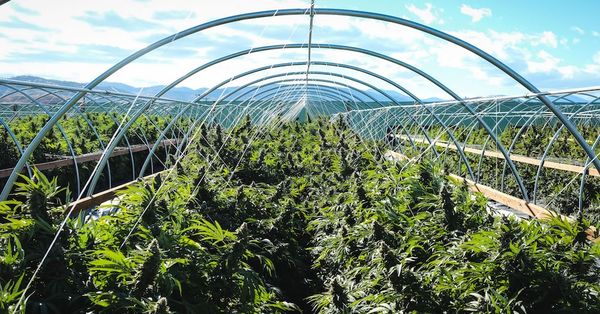
In 1892 the first effects of "El Niño" were recorded on the coasts of Peru. This climate phenomenon appears on a cyclical basis every certain amount of time and is caused by persistent warming of the waters of the Tropical Pacific, which then can influence the climate of the entire planet depending on its intensity. The consequences are devastating: they range from serious droughts to intense rain and wind that seriously affect sectors such as agriculture, something which has been noticed in Spain and California, where autumn has been extremely dry.
Since spring 2015, "El Niño" has been showing its force as it continues to grow in strength, thanks to temperatures way above the average for the surface of the sea in all of the centre and the east of the equatorial Pacific Ocean. At the moment, it is one of the three most powerful episodes recorded since 1950 and the strongest since the 1997-1998 season. The World Meteorological Organisation (WMO) warns that the maximum force of this phenomenon is expected to come between November and next January, however its effects are already evident in different areas of the globe.
According to the NOAA (National Oceanic and Atmospheric Administration), it is probable that this year "El Niño" will bring warmer temperatures to the north half of North America and colder temperatures to the south. One of the areas most affected is California and the west coast of the United States; and the effects are expected to continue until midway through 2016. This, along with regional drought that California has been experiencing for several years, has meant that the water reserves have fallen to 20% of their normal level.
Serious droughts and fires are affecting growers in the area and cannabis crops, especially in the north of Sonoma, where an abundant quantity of cannabis is produced for the medical industry. Generally speaking, the cannabis industry has been affected in Humboldt County, which is more dependent on rainfall than the water supplies that can come from supply sources from federal and state water programs.
On the other hand, it is predicted that there will be all kinds of unusual climatic effects, ranging from strong storms along the west coast of North America to more intense rain in the southeast of the United States. There will also be very strong rain lasting for a few weeks over the coming months that will also have negative consequences for crops. It is not the first time that something similar has caused landslides in the area, affecting inhabitants and damaging farming resources.
Why is "El Niño" so powerful this year? Historic accumulation of greenhouse gases
David Carlson, director of the World Program for Climate Research, co-sponsored by the WMO, recently explained that the "El Niño" of 2015 is the first time that the phenomenon has taken place since the rapid melting of the Arctic, which affects the Earth's thermostat and the ocean currents that regulate the planet's global temperature. The unprecedented combination of these two factors will lead us straight into never before experience climatic territory.
That is the situation. It seems that the planet is entering unknown territory due to the build-up of greenhouse gases in the atmosphere, which continues to grow and in 2014 reached never before seen levels. For example, according to the World Meteorological Organisation (WMO), the main gas of this type, carbon dioxide (CO2) -which has increased by 143% since the preindustrial age- is around 400 parts per million, and experts state that because of this the temperature of the planet at the end of 2015 will be 1.02 degrees higher than the average before the Industrial Revolution, the average recorded between 1850 and 1900. The excess energy trapped by CO2 and other greenhouse gases is heating up the surface of the Earth, which leads to an increase in atmospheric water vapour which, in turn, is trapping even more heat.
The current trajectory is more worrying, because climate models indicate that we are on a path that is leading to increases of around 3.5º towards the end of the century (with regard to the pre-industrial era). Furthermore, these concentrations will remain in the atmosphere for hundreds of years, which means that not only is the current climate being modified, but rather we are compromising that of future generations.
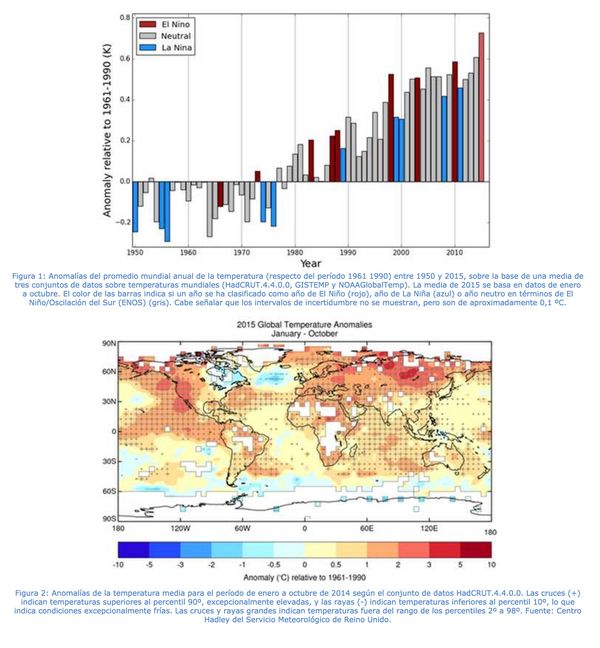
In the case of "El Niño", it will probably reach its maximum point during the 2015-16 winter in the Northern Hemisphere, with a lessening of its effects around the end of spring or beginning of summer 2016. However, the effects are already being noticed. For example, the dry conditions linked to "El Niño" in Indonesia have put down the foundations for devastating fires and the region is experiencing the largest number of forest fires since 1997. Also, all of the warm ocean waters linked to "El Niño" are causing issues for marine life due to the excess of heat; and an intense coral bleaching process is taking place.
"El Niño" also tends to exacerbate the hurricane season in the Pacific, and reduce the hurricane season in the Atlantic. So for this year, a total of 21 Category 4 and 5 storms have been recorded in the North Pacific, breaking the record of 17 set in 1997. Hurricane Patricia deserves a special mention, in October it reached land on the west coast of Mexico, becoming the most intense hurricane ever recorded in the Pacific Ocean.
The effects of "El Niño" and the drought for cannabis growers: California
A big storm on 2 November marked the official end to the 2015 cannabis season in California. Judging from the reports of growers, and despite this being the fourth year of a relentless drought, the quality of the cannabis "has been outstanding". The growers state that the long, warm and sunny summer this year prevented the mould problems suffered in 2014. The heat also meant that the harvest took place thirty days ahead of schedule, something which was significantly earlier than ever. Just like with wine, the year long drought affects the cannabis yield, which could be reduced due to a lack of water (around 20% this year), but much better quality and with more resin. The drought also kept fungi away from the plant, a problem that can ruin around 30% of a crop.
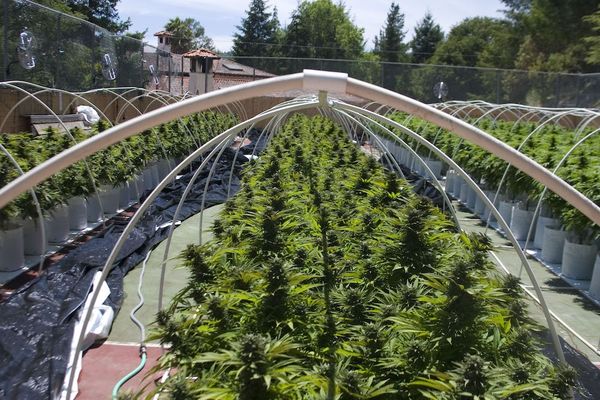
Growers at the epicentres of cannabis growing in the United States, especially in the counties of Humboldt and Mendocino, stated that the excellent crop this year, along with a rise in wholesale demand, has a led to an increase in prices for high quality outdoor cannabis, making them higher than those of last year, at around $1500 to $1800 per pound. Furthermore, the demand for cannabis in the United States seems to be increasing, as marijuana has cast off its social stigma. For the first time in recent history, cannabis growers have reported pre-sales of their crop, which means that the product has already been sold before being harvested, something which had not been seen in many years.
Growers suspect that wholesalers are alarmed by headlines about the drought and fires this year, and have begun to purchase supplies to protect themselves from a possible cannabis shortage. However, although the crop has been excellent, 2015 has been a year where growers were pilloried for the use of water, despite the fact that cannabis amounts to an insignificant fraction of the water used for farming in California.
In fact, 2015 will probably be remembered as the last unregulated medical cannabis crop in the history of California. Many growers are now using every last cent to update their watering systems, deposits, tanks or water storage ponds, to bring them into line with recent legislation relating to the matter, and also in order to apply for new state licenses that will be available over the next two years.
And in Spain? A country where the water system is heading towards collapse
In another key cannabis growing area, with almost the same climate as California but in the west of Europe, the situation also looks difficult. Spain is a country that allocates 80% of its water towards farming activity, the main sector affected by drought. According to a study presented on Wednesday in Paris as part of the Climate Change Conference held in the French capital, by 2021, Spain will have lost approximately 20% of the water resources that it held at the beginning of the 90s. Furthermore, statistics confirm an increase of 0.48 degrees to the daily average temperatures in Spain between 1973 and 2005, which means an increase in the last of water through more evaporation and evapotranspiration.
To give an example, it is not possible to remember an autumn like this in our country: November was "dry" and "very mild" in Spain, the fourth warmest of this century behind 2006, 2009 and 2014, according to the State Meteorology Agency (AEMET) which states that last month rainfall was almost 40% below normal levels. The southeast of Spain was affected even more by these circumstances, leading to the harvesting date being brought forward in earlier weeks.
The combination of heat in October during the day, along with colder nights and fewer hours of sun as autumn progressed, meant that the marijuana harvest took place a few weeks earlier, just like in California. The north of the peninsula in particular has enjoyed an unusually dry and warm autumn, which helped to produce a high quality crop, that was unaffected by the endless rain on the Cantabrian coast. Climate change has given Cantabria an autumn that would be worthy of Almería.
If we have to establish a parallel with California, it would be the province of Granada which "smells more like weed" than ever. Good climate conditions for growing marijuana have caused the crop to really take off in the region. By the end of summer, the Guardia Civil had already seized 5,330 kilograms of cannabis, more than twice the total amount last year. Crops discovered throughout the region became national news, especially due to the number of kilograms confiscated and the large size of the plants. They were like actual trees that sent statistics shooting up.
The fact is that the Granada climate encourages the rapid growth of the plant. The province has very similar conditions to the north coast of Morocco, and the Rif region, one of the world's big producers. Especially, the Alpujarra region, the primary producer of cannabis in Granada over the last few years, where landscapes or areas that are difficult to access are a perfect place for growing the plant.
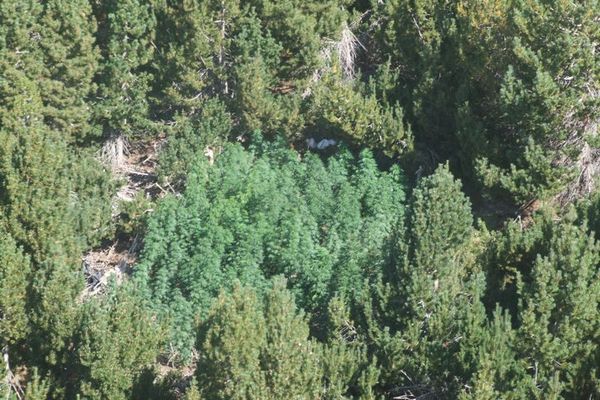
The use of greenhouses to hide large cannabis crops has also increased drastically, and is a common technique in provinces such as Almería, where it is normal for people to illegally take water from irrigation channels to use on watering systems, which lowers production costs. In a town like Albuñol (7,000 inhabitants), four large plantations in greenhouses have been detected this year alone; and one was the largest in the province, with 664 cannabis plants that measured more than two metres, which municipal workers helped to chop down using axes and electrical saws.
The mild and dry climate also encourages the use of autoflowering seeds outdoor in all areas.
For example, the largest cannabis plantation seized in Spain in 2015 was in Villarrobledo, Albacete, it was outside and in the middle of La Mancha. At the beginning of September 75,000 autoflowering cannabis plants in the flowering stage were discovered. They weighed a total of 5 tonnes, distributed between a 3 hectare farming property and an adjoining country house that was used for drying. The endless rows of plants were fitted out with a complex rubber tube network that supplied water through an underground well.
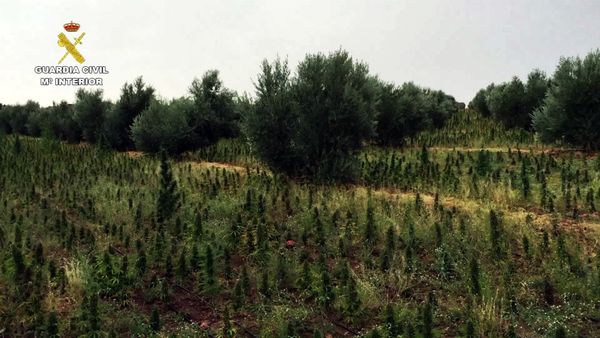
Another consequence is an improvement in the quality of outdoor crops in varieties that are especially quick and secure in moist climates such as Critical +2.0 Feminized, which increases in terms of resin and aromas and reaches maximum quality levels when it receives intense sun, warm temperatures, and low moisture levels. In fact, in such cases its fragrance and quality often surpass that of cannabis grown indoors. With such a climate, outdoor growing is increasingly considered; and it is expected that with the regulation of growing, just like in California, high quality organic outdoor growing will be increasingly valued and requested by Spanish users.
It is yet another example that shows how climate change is leading Spain towards a climate like that of Morocco, with longer summers and warmer winters, which will without doubt increase outdoor cannabis growing to unprecedented levels. The fact is, with a 2ºC temperature increase by 2050 the south of Europe would have a climate similar to that of north Africa and the north of Europe would have a similar climate to that currently found in the south of Europe.



Comments from our readers
There are no comments yet. Would you like to be the first?
Leave a comment!Did you like this post?
Your opinion about our seeds is very important to us and can help other users a lot (your email address won't be made public).